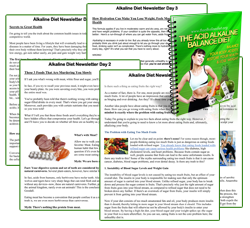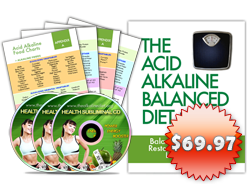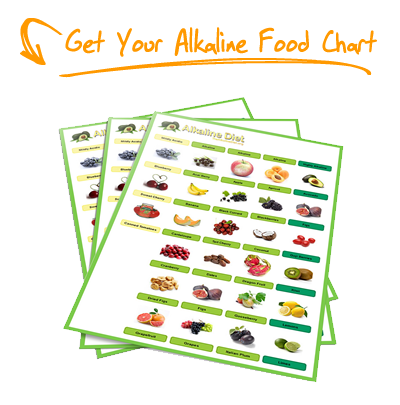Definitive Explanation To Acid And Alkaline Forming Foods
Posted on 17. May, 2010 by Emma Deangela in Alkaline Diet Tips, Alkaline Foods, Blog
With so many articles recommending alkaline diet and laying out the list of highly alkaline to slightly alkaline foods, people are still confuse why some acid food in its nature like lemons and other citrus fruits become highly alkaline. This article will try to give the best explanation as it tries to expose the systematic details of how certain foods are considered either acid or alkaline foods.
The Scientific Explanation of Acid-base Concept
In chemistry, our body has an acid-alkaline or acid-base ratio that is commonly known as ph and become balance between acid-forming; the positively charges ions, and alkaline forming; the negatively charged ions. Our body is capable to maintain ph balance if the minerals and nutrients are assimilated properly.
Alkali is a strong chemical base substance resulting in the formation of OH or hydroxyl ions and when dissolves in water it turns litmus paper into blue. It has high ph of more than 7 in range. The alkali reserves or bicarbonate ions act as buffer systems of the blood and neutralizes lactic acid produced by the body. Buffer system is mechanism which secure against sudden shifts in alkalinity to acidity. The combination of our naturally occurring weak bases and weak acids exist in balance, only if we maintain the normal ph conditions. It is amazing to know how the ph buffer systems work chemically by adjusting the proportion of acid and base.
In high school chemistry, ph is how we measure the acidity and alkalinity solution containing water. The ph 7 is neutral from the scale of 0-14 and our body needs to maintain the scale of 7 and higher. Dropping the ph level from 1-3 goes out of balance and will greatly affect the proper functioning of the system.
Effects of Lower Alkali Reserves
Lower alkali reserves can cause acidosis. Acidic byproducts have negative impact on general health that weakens the body system. A vital key to maintain proper ph balanced is to maintain enough alkaline reserves, otherwise, leaving the body fragile and susceptible to many diseases as the alkaline reserves are depleted. The acid-alkaline diet with the ratio of 80 % of alkaline predominating the 20% of acid forming foods can help to maintain the balanced body chemistry.
Faulty Acidic Diet
Most diets are high in acid content and transported by the blood to the various systems and discharge points reducing the transportation of carbon dioxide and the alkalinity of the blood. It must be properly eliminated through bowels, lungs, and kidneys. If not, the accumulation of acids in tissues is what we know the effect of acidosis with many symptoms like nervous disorders, drowsiness, nausea, headache, vomiting, and burning sensation. Furthermore, if not neutralize by consuming alkaline foods, this may serve as breeding ground for some serious diseases lowering the vitality of the system.
Knowing the Acid-alkalinity of the Blood
The effect as to whether the blood maintain its alkalinity can bee seen and tested through urine and saliva using ph strips after consumption of foods. You may wonder why the color of urine changes from time to time depending on what food we consume. Any minerals such as calcium, sodium, magnesium, and potassium present in foods may contribute to the alkalinity. On the other hand, chlorine, sulfur, and phosphorus content may give acid-forming effects.
Some Misconceptions about some Highly Alkaline Food
Why citrus fruits like lemon considered as alkaline food where in fact the nature of this is very acidic? A food may become highly alkaline if the byproducts after digested become alkaline. Generally, all foods that we eat are burned or digested, leaving an “ash” as the end product of absorption. Now, it depends on the mineral composition of food whether this ash can turn into neutral, acid, or alkaline.
Therefore, it is a common mistake to assume that any food tastes acid, has also acidic effect in the blood. Let us correct this common presumption in a conclusion that the effect of food is due to the ash or residue it leaves behind after digestion. Fruits and vegetables for instance, containing organic acids with combination of potash and soda in the form of acid salts. Yet, this is highly alkaline foods containing electrolyte minerals resulting to boost the alkalinity of the blood rather than lessen it.
What are some foods leaving an acid ash?
Animal sources foods like meat and sea foods, dairy products, fats and oils; avocado, corn, canola, flax, sesame, and sunflower oil, cereals, grain products, beans, nuts but not almonds, bread with white flour, pasta, alcoholic drinks, coffee, tea, chemical sweeteners, and chocolates are acid-forming foods and should be taken with limitations as they are productive of mucus and may hinder the absorption of nutrients.
What are some foods leaving an alkaline ash?
Fresh vegetables – fermented vegetables, onions, garlic, asparagus, parsley, carrots, cauliflower, broccoli, cabbage, Brussels sprouts, potatoes, celery, pumpkins, radishes, spinach, cucumbers, tomatoes, lettuce, beets, peppers, pumpkin, and turnips
Low-sugar fruits – melons, peaches, pineapple, apples, ripe banana, apricot, avocado, cantaloupe, cherries, all berries but not cranberries, honeydew melon, pear and citrus fruits like lemons, oranges and limes
Tubers, nuts such as almonds, apple cider vinegar, flax seeds, pumpkin seeds, sunflower seeds, sprouted seeds, green and vegetable juices, organic milk, alkaline water, herbal tea such as ginseng, dandelion, green, banchi and kombucha tea, stevia sweetener, cinnamon, curry, mustard, sea salt, and all herbs are alkaline-producing foods.
In a Nutshell
The alkaline diet is based on the theory that certain foods, after consumed and digested, leave an alkaline residue. Many of the proponents of alkaline diet claimed that maintaining the correct ph in our blood may prevent obesity, fatigue, allergies, bone disorders, cancer and other various diseases. Therefore, it simply boils down to what food we choose to eat and what lifestyle we opt to live.





Recent Comments